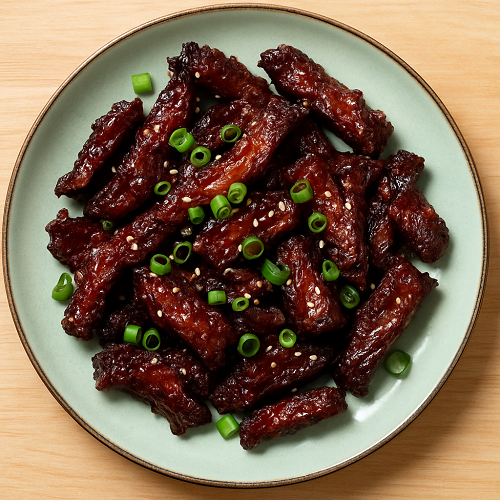Bulgogi: The Ultimate Korean BBQ Beef Recipe (Better than “Easy Bulgogi”)


What Is Bulgogi?
- Definition & Etymology: “Bulgogi” literally means “fire meat” in Korean—bul (fire) + gogi (meat). Originating from Korean BBQ traditions, traditional preparation involved grilling thinly marinated beef over charcoal.
- Cultural Origin: Hails from Korea’s Goguryeo period. Over centuries, has become a mainstay in Korean BBQ culture and home cooking.
- Traditional Ingredients often include: soy sauce, sugar or sweeteners (often unrefined or brown sugar), garlic, onions, sesame oil, pear or Asian pear for tenderizing, ginger, sesame seeds.
Why This Recipe Will Be Even Better Than the “Easy Bulgogi” Recipe
While the “Easy Bulgogi (Korean BBQ Beef)” recipe from AllRecipes is simple and widely loved (10 min prep, 5 min cook, ~1 hr marination) this version improves upon it by:
- Using fruit tenderizers (Asian pear or kiwi) for natural sweetness + better texture.
- Offering multiple cooking methods (skillet, grill, oven, air fryer) so you can adapt to your kitchen.
- More balanced seasoning (adding mirin or rice wine, adjusting sweet/savory/spice ratio).
- Including vegetable and banchan pairing suggestions for a more complete meal.
- Detailed tips for slicing, marinating, caramelizing, and serving to achieve the ideal texture and flavor.
Best Cuts of Beef – What to Use & How to Slice It
| Cut | Why It Works | What to Look For |
|---|---|---|
| Ribeye / Rib Steak | Very well‑marbled, rich flavor; slices stay juicy | Thick fat lines, soft to the touch, not dry |
| Sirloin (Top Sirloin) | Leaner, good flavor, more affordable | Ask butcher to sheath and partially freeze to slice thinly |
| Flank Steak / Skirt Steak | Chewy texture, great for grilling; absorbs marinade well | Cut across the grain, 1/16‑1/8 inch (≈ 1‑2 mm) thin slices |
| Tenderloin (Fillet) | Ultra tender, milder flavor; use sparingly due to cost | Very little fat, tender texture; ideal for special occasions |
Tips for Slicing:
- Partially freeze the beef for 30‑45 minutes; that makes thin slicing easier.
- Use a sharp knife or very thin slicer; cut across the grain.
- Avoid slices that are too thick – you want quick cook, caramelization, and that slightly crispy edge.
The Marinade: Authentic Components + Enhanced Flavor Options
Here are the core marinade ingredients, plus optional ingredients to elevate flavor:
| Core Ingredient | Role in the Marinade |
|---|---|
| Soy sauce (light, naturally brewed) | Umami, salt base |
| Sugar / Brown sugar / Honey | Sweetness, helps caramelization |
| Garlic, minced | Pungent, aroma |
| Onion (grated or thinly sliced) | Adds sweetness & moisture |
| Sesame oil (toasted) | Nutty aroma, depth |
| Ginger (fresh) | Brightness, warmth |
| Sesame seeds | Texture + garnish |
| Green onions (scallions) – whites for marinade, greens for finishing | Freshness & visually appealing |
Optional Enhancers:
- Asian pear / apple / kiwi (grated) – natural tenderizer and sweetness.
- Mirin or Korean rice wine – adds depth and slight acidity.
- Gochujang or red pepper paste / flakes – for spice.
- Black pepper, white pepper or a dash of MSG (optional, for umami).
- Charcoal smoke / burnt sugar glaze – for more BBQ style char.
Step‑by‑Step Cooking Guide
Here are multiple methods; use the one that suits your setup.
Skillet or Wok (Fastest)
- Mix marinade, add beef slices, let marinate min 1 hour, ideally overnight.
- Preheat skillet or wok on high heat; add a small amount of neutral oil.
- Cook in batches, so meat doesn’t steam; leave space so caramelization happens.
- Once edges start browning, add honey or extra sugar glaze in final 1 minute to get that glossy finish.
Grill / Charcoal BBQ
- Use wire rack or grill grate; cooking over charcoal gives smoky flavor.
- Grill for 1‑2 min per side; watch carefully to avoid burning sugar.
Oven / Broiler
- Spread meat in a single layer on a baking sheet or broiler pan.
- Broil for 3‑5 minutes per side, watching closely. Crisp edges, tender center.
Air Fryer
- Preheat air fryer to ~ 400°F (200°C).
- Cook in small batches, shaking halfway. Time ~4‑7 minutes depending on thickness.
Serving Suggestions & Side Dishes
A polished Bulgogi meal isn’t just about the meat. Serve with:
- Steamed white rice (short‑grain) or bap.
- Lettuce or perilla leaves for wraps (ssam) + ssamjang or fermented sauces.
- Kimchi, cucumber salad, mung bean sprouts, pickled radishes (banchan).
- Scallions, toasted sesame seeds for garnish.
- Optional: soft fried egg, rice topped with bean sprouts, grilled mushrooms / onions.
Nutrition & Dietary Modifications
- Caloric breakdown depends heavily on meat cut and sugar content. The AllRecipes version is ~226 cal per serving (for 6 servings) with ~21g protein and ~10g fat.
- To reduce sugar: use less sugar, substitute with erythritol or a small amount of stevia/honey.
- For lower sodium: choose low‑sodium soy sauce or tamari.
- For keto / low‑carb: omit sugar entirely or use sugar alternatives; serve over cauliflower rice.
Make‑Ahead, Storage & Reheating
- Marinade ahead: You can marinate beef up to 24 hours (longer time increases flavor).
- Freezing: Marinated beef can be frozen (in zip‑top bags), thawed overnight in fridge.
- Leftovers: Store cooked bulgogi in airtight container; reheating in skillet with splash of water / broth keeps it moist. Avoid microwave if possible (turns chewy).
Common Mistakes & How to Avoid Them
| Mistake | Effect | Fix |
|---|---|---|
| Slicing meat too thick | Becomes chewy, slow‑cooked texture | Freeze briefly & slice thin across grain |
| Crowding the pan | Meat steams rather than browns | Cook in batches, high heat |
| Over‑marinating (with fruit) | Meat becomes mushy | Limit to 12‑24 hrs depending on tenderizer |
| High sugar burns | Bitter char | Watch closely, sugar glaze last minute, reduce heat |
| Salt imbalance | Too salty or bland | Taste marinade; adjust soy or salt; use low‑sodium soy sauce if needed |
Frequently Asked Questions (FAQs)
Q1. Can I use pork, chicken, or tofu instead of beef?
Yes — pork bulgogi (daeji bulgogi) and chicken work well with similar marinades. For tofu or mushrooms, press to remove moisture and marinate longer.
Q2. What if I don’t have Asian pear?
Use apple, kiwi, or pineapple (tiny amount) as tenderizer. Or omit and rely on slicing thin.
Q3. Is it authentic without pear or fruit?
Authenticity comes down to balance of soy, sugar, garlic, sesame, and correct slicing & cooking. Fruit adds traditional flavor and enzymatic tenderization but is not strictly mandatory.
Q4. How spicy is it?
Standard versions are mildly spicy. Add gochugaru, fresh chili, or gochujang for more heat.
Q5. Can I reuse the marinade?
If used raw with meat, discard boiled marinade. If you want a sauce, boil it fully before using as condiment.
Recipe: Ultimate Bulgogi (Serves 4‑6)
Ingredients
- 1.5 pounds beef (ribeye or sirloin), partially frozen, thinly sliced across the grain
- ½ Asian pear or 1 small apple, grated (≈ ¼ cup) (optional but recommended)
- ⅓ cup low‑sodium soy sauce
- 2 Tbsp mirin or Korean rice wine (optional but flavor‑boosting)
- 2 Tbsp brown sugar or white sugar (adjust to taste)
- 2 Tbsp honey (for glaze)
- 1 Tbsp toasted sesame oil
- 4 cloves garlic, minced
- 1 Tbsp fresh ginger, minced
- 1 small yellow onion, thinly sliced or grated
- 2 green onions, chopped (white part for marinade, green part for garnish)
- 1 Tbsp sesame seeds, toasted
- ¼ tsp Korean red pepper flakes or 1 Tbsp gochujang paste (for spicy version)
- Black pepper to taste
Instructions
- Prepare the beef: Partially freeze for ~30 min so slicing thin is easier. Slice thinly (1‑2 mm) across the grain.
- Make the marinade: In a bowl, whisk soy sauce, mirin, grated pear/apple, sugar, sesame oil, garlic, ginger, onion, and (if using) red pepper flakes or gochujang.
- Marinate: Add beef slices and white parts of green onions. Toss to coat. Cover and refrigerate for at least 1 hour, preferably 4‑12 hours or overnight.
- Cook (choose method):
- Skillet / Wok: Preheat to high, add neutral oil. Cook beef in batches until caramelized (2‑3 min each batch). Add honey near end for glaze.
- Grill: Preheat grill; cook slices quickly over high heat (~1‑2 min per side).
- Broiler / Oven: Use broiler, place meat close to heat source; cook 3‑5 min per side with caramelization.
- Air Fryer: Cook at 400°F (200°C) in small batches for ~5 min, shaking or flipping mid‑way.
- Garnish & serve: Sprinkle with green onion tops, sesame seeds. Serve with rice, lettuce wraps, and sides.
Shopping List & Tools Needed
- Tools: Sharp chef’s knife; mandoline or slicer optional; large mixing bowl; wok or heavy skillet; grill pan or grill; baking sheet or broiler pan (if oven); air fryer (optional); pepper mill.
- Ingredients to purchase: high‑quality soy sauce, sesame oil (toasted), fresh sesame seeds, garlic/ginger, green onion, fruit for tenderizer if using; good quality beef with marbling.
Final Tips to Nail the Dish
- Get maximum caramelization by not overcrowding the pan and using high heat.
- Let marinade rest — flavor and texture improve with time.
- Balance sweet & salt: taste marinade before adding meat.
- Use fresh garnishes last minute to preserve color and texture (green onions, sesame seeds).



